Stress Free Kids publishes audio and picture books that help children reduce stress and lower anxiety. These stories are available in Spanish and are fabulous language learning tools. The stories teach relaxation techniques, but their structure and objective also create an excellent Spanish learning experience. As children listen to these stories, they relax, but they are never passive. Children participate, both physically and by actively using their imaginations.
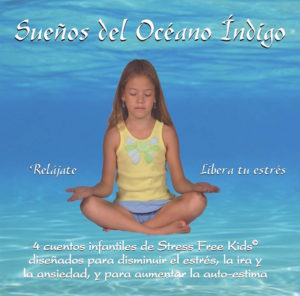 Thanks so much to Jennifer Brunk of Spanish Playground for this thorough write up. Her love for finding resources for teaching Spanish to children can be seen at her website.
Thanks so much to Jennifer Brunk of Spanish Playground for this thorough write up. Her love for finding resources for teaching Spanish to children can be seen at her website.
The CD Sueños del Océano índigo has four stories that are also available as picture books. The books provide the visual support Spanish learners need to be able to enjoy and learn from the wonderful audio. The audio CD and the books are available on the Stress Free Kids website, Amazon and iTunes. You can find activity suggestions for each story in the second half of this post. New Spanish/English Immersion Kit just released.
Outstanding Features For Language Learners
– Vocabulary and Sentence Structure
These stories establish a setting and a context. All of the words relate directly to that setting and the stories are told in simple sentences. For native speakers, this allows them to easily create mental images. For language learners, it helps them master the Spanish vocabulary as they create those images.
– Patterns
These are pattern stories. Each one has an internal structure that is repeated. Classic children’s stories such as Goldilocks and the Three Bears are also pattern stories. Repetition and predictability increase comprehension as children are exposed to the same words and sentence structures again and again.
The stories from Sueños del océano índigo, use patterns and repetition extensively and effectively. For native speakers, the repetition and predictability pulls children into the rhythm of the story and relaxes them. For Spanish learners, it gives them the opportunity to listen, comprehend, absorb and anticipate.
– Narration
The clarity, rate of speech and rhythm of the audio make the stories particularly appropriate for Spanish-language learners. For native speakers, the goal is that children catch every word without straining or guessing, that listening be effortless. This ensures that children learning the language will hear the words clearly and have time to absorb them. It is important to note that the rhythm of the narration is never monotonous or boring. The expression and quality of voice keeps listeners engaged.
– Physical Component
The stories engage children physically by having them contract and relax parts of the body, breathe in and out, and imagine different sensations. This awareness is part of the stories, so that children experience the language and the physical responses in context.
– Visualization
The stories use images from the book, children’s own mental pictures and sound effects to engage their imaginations. These images and sounds combine to reinforce the meaning of Spanish words.
– Positive Associations
Listening to these stories is relaxing and calming. They teach positive messages, instilling happiness and confidence. These are wonderful associations for children to have with Spanish.
– Instruction in Relaxation
A relaxed, clear mind lets children absorb the sound and experience the language at a deep level. As the story progresses, they are more relaxed and also more familiar with the pattern and vocabulary. As their comprehension increases, their open minds are ready to internalize the language, creating a powerful learning experience.
– Convenience for Parents and Teachers
Although many parents and teachers intend on fitting more Spanish into the day, it is not easy to do. These stories can be incorporated into a bedtime routine or transitions without having to set aside extra time. Once the stories are familiar, they actually make routines easier.
Using the Stories with Spanish Language Learners
Picture Book and Audio Combination
Either the picture book or the audio of these stories can create an excellent language learning experience. However, parents and teachers will find using the two together is most effective and much less work for them. With the pictures, children understand and learn new vocabulary. With the audio, they listen to beautiful Spanish narration carefully designed to support the content of the stories and learning.
Start with the book alone or by following along as you listen to the story. Use simple sentences to paraphrase the first pages that establish the setting and problem. Point to the pictures to help children understand. Pause and together follow the instructions in the narration. Later, when you are sure children understand the key words, listen to the audio without the book. Come back to the book on a regular basis to reinforce meaning and let the illustrations support the listening experience. The four books and audio CD are available in a special package on the Stress Free Kids website.
Cross-curricular lessons
Spanish stories from Stress Free Kids are excellent material for cross-curricular lessons with health, the environment, ocean life, art and other areas.
Pre-reading and Extension Activities for Home or Classroom
The stories lend themselves to engaging pre-reading and pre-listening activities at home or at school. Doing these activates prior knowledge and teaches key vocabulary. The activities can also be done after reading the story to reinforce the language and build on the content.
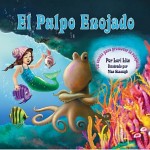
El pulpo enojado – Vocabulary related to sea life, body parts, feelings
– Talk about photographs of octopi and lobster. Use the words el mar, el pulpo, la tinta, and la langosta.
– Review body parts by singing songs or playing Simón Dice. Draw and label pictures. Be sure to introduce new body part vocabulary. These are the words for body parts in the story: la cara, los ojos, el cuerpo, los músculos, el estómago, la nariz, la boca, los pies, los dedos de pie, las piernas, las caderas, el vientre, la espalda, el pecho, el cuello, los hombros, los brazos, las manos, los dedos, la mandíbula, los labios, la piel, la frente, la cabeza.
– Identify photographs of emotions used in the story: enojado, tranquilo, quieto, etc.
Have children share what makes them feel angry or calm. Have children illustrate and label the emotions.
– Make a jardín de conchas y piedras like the one the octopus has. If possible, use shells, stones, sand and water. Use the vocabulary as much as possible as you make the garden. Children can also draw their gardens and add pictures or stickers of shells.
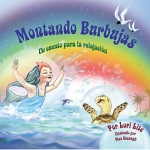
Montando burbujas – Vocabulary related to sea life, body parts, colors, feelings
– Blow bubbles. Use the words burbuja and flotar. Seeing bubbles and hearing the words will help children visualize the story.
– Knot together colored scarves or scraps of material in the order the colors appear in the story. As children listen, they hold the color. These are the colors in the story: rojo, naranja, amarillo, verde, azul, morado, blanco
– Identify photographs of emotions used in the story: cansado, tenso, quieto, tranquilo
Have children share what makes them feel different ways. They can illustrate and label the emotions.
– Play with food coloring in water. Watch how it disperses. Use the color words, fluir, corriente and vaciar as you pour and move the water.
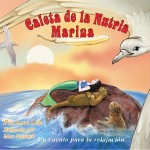
Caleta de la nutria marina – Vocabulary related to sea life, geography, body parts
– Talk about photographs and videos of sea otters
– Talk about breathing. Use the words el vientre, la nariz, respirar, adentro, afuera
– Illustrate the setting of the story as a follow-up activity. Label la caleta, las rocas, la gaviota, las nutrias marinas, etc. Older children can create a diorama.
– With older children make origami sea otters. Do other sea otter crafts with younger children.
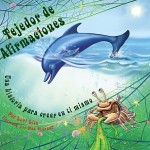
Tejedor de afirmaciones – Vocabulary related to sea life, positive self-esteem
– Talk about photographs and videos of dolphins jumping
– Talk about photographs of the sea life in the story: el delfín, el pez globo, la estrella de mar, la medusa, el caracol, la langosta, el caballito de mar, la almeja, el pez ángel, el cangrejo ermitaño, la platija
– Read the story as a readers theater or with puppets of the sea animals made with pictures and craft sticks. The story is excellent for this activity because each sea creature has a line. One child can present several affirmations.
– Give children pictures of the animals to order as they listen.
– Kids can draw and label the sea life in the story or label pictures you provide. Put the affirmations for each in dialog bubbles.
– Identify photographs of emotions used in the story: triste, desanimado, feliz etc. Have children share what makes them feel different ways. Children can illustrate and label the emotions.
– This story encourages Spanish language production. It specifically asks children to repeat the affirmations. Encourage them to do so as they listen to the story.
– Remind kids of one or two affirmations to use when they are playing. Suggest different affirmations on different days. Model using the affirmations as you interact with the children.
– The affirmations in the story are short sentences like these:
A mí me gusta como soy.
Yo creo en mí misma.
Yo soy feliz.
Puedo hacerlo.
Yo soy creativo.
Yo sí puedo.
The stories on Sueños del océano índigo provide a unique opportunity for children learning Spanish. The combination of audio, illustrations, and physical awareness, all in the context of a story, creates a rich learning experience. These materials are intended to teach relaxation techniques, but their design compliments language learning in every way. If you want to add more Spanish to your home or classroom, Sueños del océano índigo may well be the answer.